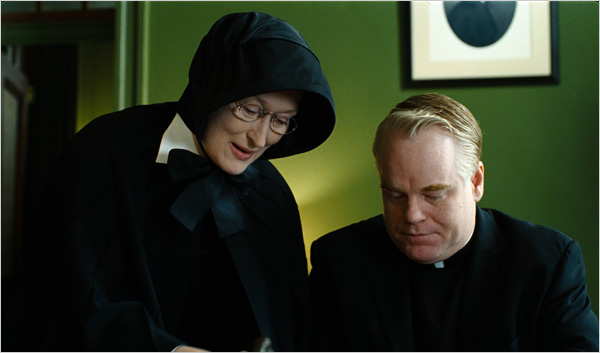The American novelist Flannery O’Connor once wrote in a letter to a friend, ‘I think there is no suffering greater than what is caused by the doubts of those who want to believe. I know what torment this is, but I can only see it, in myself anyway, as the process by which faith is deepened.’
It is the absence of certainty in life that is explored with such subtle intelligence and complexity by Director John Patrick Shanley in the screen adaptation of his successful Broadway play Doubt, out this month in cinemas.
The story is set in Shanley’s old neighbourhood, the Bronx, at St Nicholas Catholic School. It is 1964 and the small church school run by the Sisters of Charity is, like the rest of society, on the brink of a new era. A burgeoning challenge to government, the military, the church and other previously unquestioned arms of the establishment, represents a wave the school can’t escape despite the efforts of some to cling to the past. An autumnal setting throughout the film powerfully evokes this end of one era and dawning of a new.

It is the energetic, affable and creative pastor, Father Flynn (Philip Seymour Hoffman) who challenges the school’s tradition of strict and demanding discipline most notably upheld by the Principal, Sister Aloysius (Meryl Streep). The two are set to collide and caught up in the wreckage is the delightfully earnest and naïve Sister James, played by Amy Adams.
St Nicholas has just taken on its first black student, Donald Miller. When Sister James becomes concerned that the attention Father Flynn is paying the boy may not be entirely innocent, she shares her fears with Sister Aloysius, sending the older nun into an unrelenting campaign to rid the school of the suspect Flynn.
Streep’s character is set rock hard in her ways and her suspicions. She is determined to get her man and will go to any length to do so. In her mind the ends more than justifies the shady means at her disposal. Her quest could be interpreted as a noble effort to protect a vulnerable child. But it is hard to escape the feeling that it’s more about her personal failures, hurts and guilt than genuine love and sacrifice. At virtually every other point in the story whatever compassion she has, a quality in abundance in Flynn, is well hidden.
Director John Shanley says the film is about the struggle for certainty in an uncertain world, and what it means to be human within that struggle. There are many themes here that speak with understated sophistication and sensitivity of human frailty and responsibility; the damage done by damaged people; sin and its consequences; human love and motivation.
But most evident is an exploration of the ‘grey’ of life—the undefined elements of existence. It is not a black and white world. People are a complicated mixture of good and bad. Sister Aloysius appears unable to exist in such a space. She needs right and wrong and absolutes. An alternative vision, while unconscionable to her, appears a more realistic and honest means of negotiating the world.
A sermon from Father Flynn, wonderfully delivered by Seymour-Hoffman, offers the line ‘Doubt can be a bond as powerful as certainty.’ That he is willing to live within that doubt is one positive aspect of his character that Shanley wishes to highlight. Certainty may be desirable—“I wish I could be like you”, says sister James to her Principal—but it is rarely available and, perhaps not even advisable.
The sort of faith that allows no room for doubt may ultimately be frail and limited.
Streep’s characters are typically full of unspoken complexity and depth, and Sister Aloysius is no exception. The director is not unsympathetic to her plight and presents her as anything but one-dimensional. Yet the overwhelming sense is of a cold and withdrawn figure that has long ago abandoned optimism, hope and colour. The Sisters of Mercy wear a nun’s habit that was modelled on Italian funeral wear and it suits her demeanour. She is constantly closing windows from the inside, trying to hold back the cold winds that try to force their way into her world. By contrast, the younger Sister James makes a point of opening windows and allowing the air to rush in just as she represents the fresh air of change in the culture and the church.
The wind plays quite a role in the film. No coincidence here that in the Bible the Holy Spirit is portrayed as a wind that blows “wherever it pleases. You hear its sound, but you cannot tell where it comes from or where it is going” (John 3:8) Both this passage and the film suggest the need to be open to the movement of the Spirit and all the mystery that entails.
The sort of faith that allows no room for doubt may ultimately be frail and limited. The faith of each character is tested. Their worlds are rocked. Their sense of their fellow humans, their church and their God faces stiff and uncomfortable challenges. Yet as actress Amy Adams says of her role in the film, ‘doubt can be a journey to a new found truth.’ Deep faith that honestly wrestles with the murky aspects of life, the parts that cannot be reduced to simple equations, measurable quantities and glib answers may in the end be the most enduring and sturdy of all.
Simon Smart is a Director at CPX.


